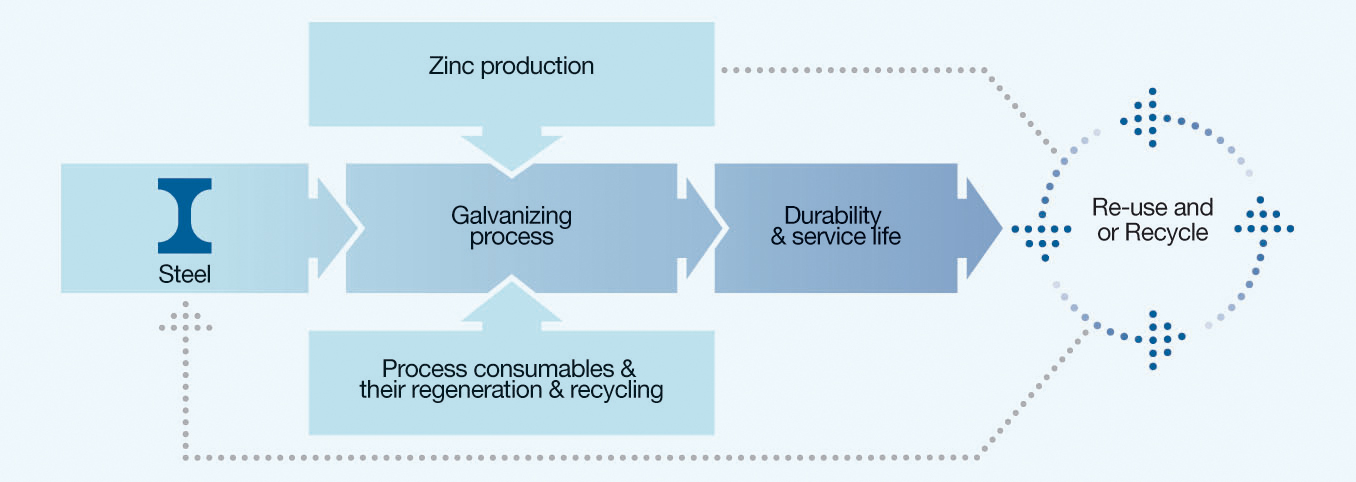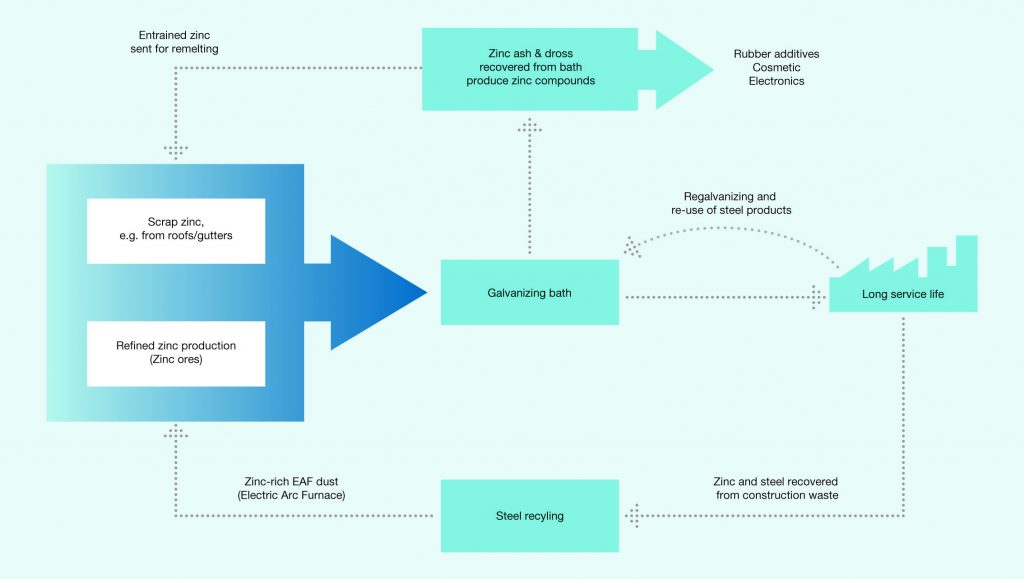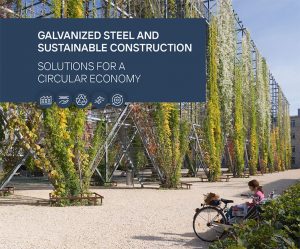Attention to durability of steel structures and components has important environmental, economic and social consequences. Some of these are less obvious than others.
The overall economic cost of corrosion has been studied in several countries. It is commonly estimated at up to 4% of gross domestic product.
The long-term durability provided by galvanizing is achieved at relatively low environmental burden in terms of energy and other globally relevant impacts, especially when compared to the energy value of the steel it is protecting.
Several studies have demonstrated the high economic and environmental costs associated with the repeated maintenance painting of steel structures. These burdens ‘ can be significantly reduced by an initial investment in long-term protection.

Life Cycle of Hot Dip Galvanizing
Lack of attention to optimal corrosion protection can leave a damaging economic legacy of repeated maintenance costs. In social housing projects, future maintenance costs will be borne by the local authorities. In public infrastructure projects, use of galvanized steel leads to lower maintenance budgets, releasing public funds for other purposes.

Flows of Recycled Zinc in Galvanizing Process and at the End of Life
Galvanizing and Sustainable Construction
In response to revised goals, the UK and Ireland Galvanizers Association have collaborated with EGGA, the European General Galvanizers Association to outline how galvanizing sits within the new circular framework.
The resulting publication, ‘Galvanized Steel and Sustainable Construction – Solutions for a Circular Economy‘ outlines the role galvanizing plays in keeping buildings, infrastructure and resources in use for as long as possible, and how as part of a circular construction model, galvanizing can help manage growing global demand in the face of low carbon goals.
Life Cycle Inventory Study
GA has worked in conjunction with the European industry via the European General Galvanizers Association (EGGA) to complete an extensive Life Cycle Inventory (LCI) study to determine average environmental burdens required to give lifetime protection for steel products.
The study was carried out by Life Cycle Engineering srl (Italy) and collected detailed environmental information from 66 galvanizing plants producing over 1 million tonnes of coated steel work in 14 countries.
LCE worked closely with EGGA’s national associations to collate the sample. The sample was then carefully checked to be representative of the mix of technology used across the industry. The LCI data are fully comprehensive – covering every aspect of the galvanizing process, from raw materials to process energy and ancillary operations.
The LCI data is available, on request, to LCA professionals who are engaged in relevant life cycle studies for galvanized products.
Find out more about the LCI Study | Email us to request it
Multistorey Car Park – Comparison between a Paint Coating and Galvanizing
 A 2006 study by the Environmental Technology Systems Department at the Technical University of Berlin involved a comparison between a paint coating (as EN ISO 12944) and hot dip galvanizing (EN ISO 1461) for a steel car park on the basis of a life cycle assessment.
A 2006 study by the Environmental Technology Systems Department at the Technical University of Berlin involved a comparison between a paint coating (as EN ISO 12944) and hot dip galvanizing (EN ISO 1461) for a steel car park on the basis of a life cycle assessment.
Two systems had to provide corrosion prevention for a steel structure which was to be used for 60 years, and which was applied to a steel structure such as a multi-storey car park with a steel area amounting to 20 m²/t.
‘Producta’ Balcony Structure – Life Cycle Assessment
 In order to assess the impacts of hot dip galvanizing and painting separately on Producta’ balcony systems, two coating specifications were defined to cover the required 60-year service life.
In order to assess the impacts of hot dip galvanizing and painting separately on Producta’ balcony systems, two coating specifications were defined to cover the required 60-year service life.
The objectives were to provide a basis for future improvements in life cycle performance of zinc products; to establish environmental performance of a hot dip galvanized steel structure and an equivalent painted structure and to identify the relative importance of coating selection to overall life cycle environmental impact of steel structures.
A Life Cycle Approach to Comparing Galvanized Steel with Aluminium for Lighting Poles
 The choice was between galvanized steel and anodized aluminium poles that have a light point height of 9 metres.
The choice was between galvanized steel and anodized aluminium poles that have a light point height of 9 metres.
A ‘Cradle-to-Grave’ LCA was made including demolition and end-of-life scenarios and using the ReCiPe method. Two scenarios were studied. One with the sector average recycled content (30% secondary steel and 40% aluminium) and a second scenario with both materials with 95% recycled content.

